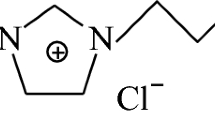Abstract
This paper systematically studied the extraction process of total flavonoids from quinoa and the kinetics of macroporous resin purification. On the basis of single-factor experiments, the optimum extraction and purification process of total flavonoids from quinoa was studied by orthogonal experiments. The results showed that the optimum extraction conditions were as follows: ultrasonic time 25 min, temperature 200 °F, solid-liquid ratio 1:10 (g/mL), reflux time 2 h, and ethanol concentration 90%. Under this condition, the total flavonoids extracted from quinoa was 3.859 mg/g. Fifteen percent NaCl was added to salt out protein from flavonoid solution. The best macroporous resin purification process was as follows: pH 2, flow rate 2 BV/h, 0.3 mg/mL flavonoid solution loading, 8 BV water wash with acetone elution. Under this condition, the adsorption rate of purified flavonoids was 80.89%. The purity can be increased from 7.09% of the initial extract to 28.48%.









Similar content being viewed by others
Change history
11 August 2021
A Correction to this paper has been published: https://doi.org/10.1007/s11051-021-05226-0
References
Dini I, Tenore GC, Dini A (2010) Antioxidant compound contents and antioxidant activity before and after cooking in sweet and bitter Chenopodium quinoa seeds. LWT Food Sci Technol 43:447–451
Fernandes de Jesus Souza F i v, Ivano AD, Itamar RT, Carlos RS (2016) Physiological quality of quinoa seeds submitted to different storage conditions. Afr J Agric Res 11(15):1299–1308
Hebatollah I, Maksimovic JD, Maksimovic V, Shabala L, Živanovic BD, Tian Y, Jacobsen S-E, Shabala S (2016) Rutin, a flavonoid with antioxidant activity, improves plant salinity tolerance by regulating K+ retention and Na+ exclusion from leaf mesophyll in quinoa and broad beans. Funct Plant Biol 43:75–86
Jacobsen S-E (2003) The worldwide potential for quinoa (Chenopodium quinoa Willd.). Food Rev Int 19:167–177
Jacobsen S-E, Mujica A, Jensen CR (2003) The Resistance of Quinoa (Chenopodium quinoawilld.) to adverse abiotic factors. Food Rev Int 19(1–2):99–109
Joo SH, Dong JS, Chang HO, Wang JP, Jin TP (2017) Application of Co and Mn for a Co-Mn-Br or Co-Mn-C2H3O2 petroleum liquid catalyst from the cathode material of spent lithium ion batteries by a hydrometallurgical route. J Mater Sci 7(10):439
Laffort P (2016) A revisited definition of the three solute descriptors related to the Van der Waals forces in solutions.J Phys Chem 6(4):86–100
Leyton A, Vergara-Salinas JR, Pérez-Correa JR, Lienqueo ME (2017) Purification of phlorotannins from Macrocystis pyrifera using macroporous resins. Food Chem 237:312–319
Li N, Hanfeng D, Junjie H, Yongchao G (2017) The adaptive planting and development prospect of quinoa in China. Chin Agric Sci Bull 33(10):31–36
Navruz-Varli S, Sanlier N (2016) Nutritional and health benefits of quinoa (Chenopodium quinoa Willd.). J Cereal Sci 69:371–376
Qi X, Liqin Z, Weijun C, Yunfei S, Pan S (2005) Method for isolation and purification of mogrosides with macroporous resin. Trans CSAE 21(9):163–166
Ren G, Xiushi Y, Yang Y (2015) Current situation of quinoa industry in China. Crops 5:1–5
Srijan A, Bodhidatta L, Mason CJ, Bunyarakyothin G, Jiarakul W (2013) Application of transcutaneous puncture drainage directed by B-ultrasound for treatment of severe acute pancreatitis. Enzymologia 32(32):189–197
Wang Y, He J, Hui C, Disheng Z, Hua C, Huibo S (2006) Analysis of flavones in Rubus parvifolius Linn by high performance liquid chromatography-electrospray ionization mass spectroscopy and thin layer chromatography-Fourier transform surface enhanced Raman spectroscopy. Chin J Anal Chem 8:1073–1077
Weifeng X, Wang S, Cheng Q, Jiang P, Zhang P, Tang K (2018) Kinetic study on reactive extraction of clorprenaline enantiomers with a combined chiral selector. Sep Sci Technol 53(1):110–116
Xiao W, Han L, Shi B (2008) Microwave-assisted extraction of flavonoids from Radix Astragali. Sep Purif Technol 62(3):614–618
Yael B, Galili L, Badani H, Hovav R, Galili S (2012) Total phenolic content and antioxidant activity of red and yellow quinoa (Chenopodium quinoa Willd.) seeds as affected by baking and cooking conditions. Food Nutr Sci 3:1150–1155
Yao Y, Yang XS, Shi ZX (2014) Anti-inflammatory activity of saponins from quinoa (Chenopodium quinoa Willd.) seeds in lipopolysaccharide-stimulated RAW264.7 macrophages cells. J Food Sci 79(5):1018–1023
Yuko H, Fujita T, Ishii T, Ueno N (2010) Antioxidative properties and flavonoid composition of Chenopodium quinoa seeds cultivated in Japan. Food Chem 119:1300–1306
Zhang Y, Shufen LI, Xiwen WU, Zhao X (2007) Macroporous resin adsorption for purification of flavonoids in Houttuynia cordata Thunb. Chin J Chem Eng 15(6):872–876
Zhang YF, Tian MK, Kui XU (2017) Current development of membrane separation technology. Mod Chem Ind 37(4):6–10
Zhuang M, Zhao M, Lin L, Dong Y, Chen H (2016) Macroporous resin purification of peptides with umami taste from soy sauce. Food Chem 190:338–344
Zurita-Silva A, Fuentes F, Zamora P (2014) Breeding quinoa (Chenopodium quinoa Willd.): potential and perspectives. Mol Breed 34:13–30
Acknowledgments
This work was supported by the Key Laboratory of Coarse Cereal Processing, Ministry of Agriculture and Rural Affairs, Chengdu University (No. 2017Y0012).
Author information
Authors and Affiliations
Corresponding author
Ethics declarations
Conflict of interest
The authors declare that they have no conflict of interest.
Additional information
Publisher’s note
Springer Nature remains neutral with regard to jurisdictional claims in published maps and institutional affiliations.
This article is part of the topical collection on Role of Nanotechnology and Internet of Things in Healthcare
This article has been retracted. Please see the retraction notice for more detail: https://doi.org/10.1007/s11051-021-05226-0
About this article
Cite this article
Xiaoyong, W., Yuan, T., Yanxia, S. et al. RETRACTED ARTICLE: Extraction of flavonoids and kinetics of purification by macroporous resins from quinoa. J Nanopart Res 22, 181 (2020). https://doi.org/10.1007/s11051-020-04906-7
Received:
Accepted:
Published:
DOI: https://doi.org/10.1007/s11051-020-04906-7




